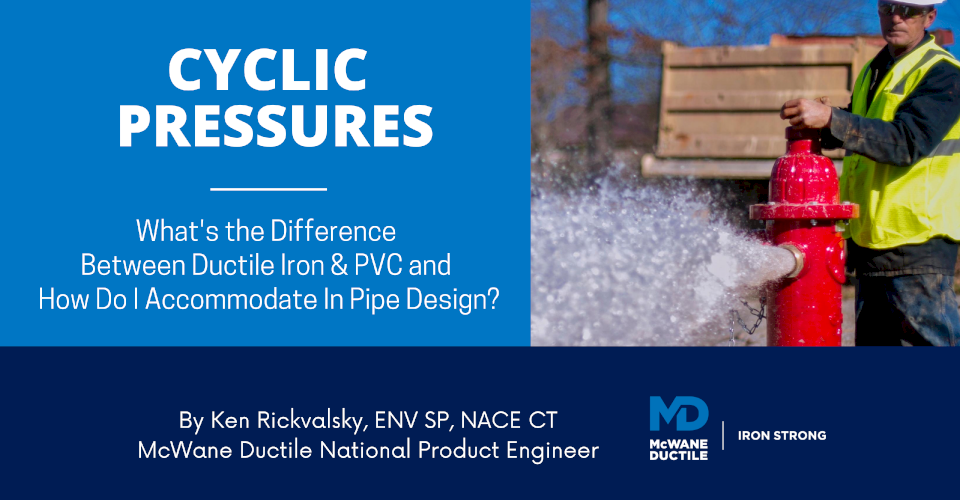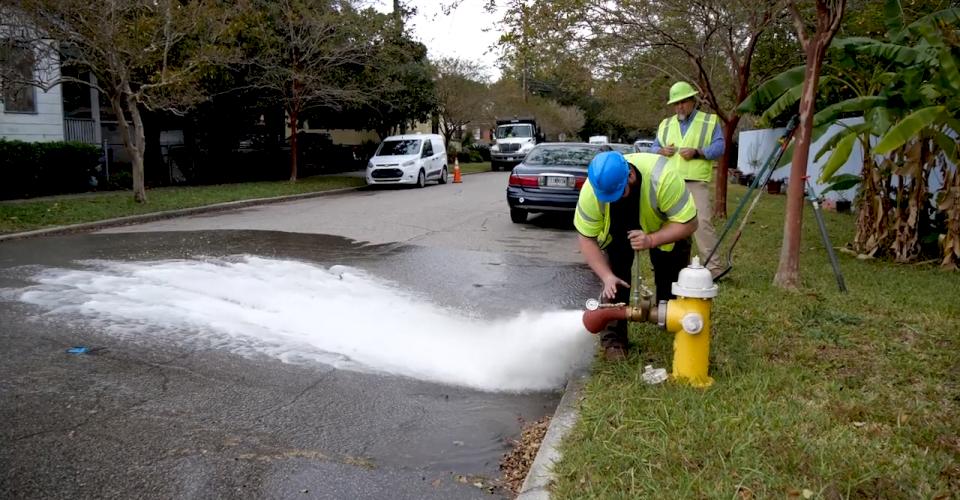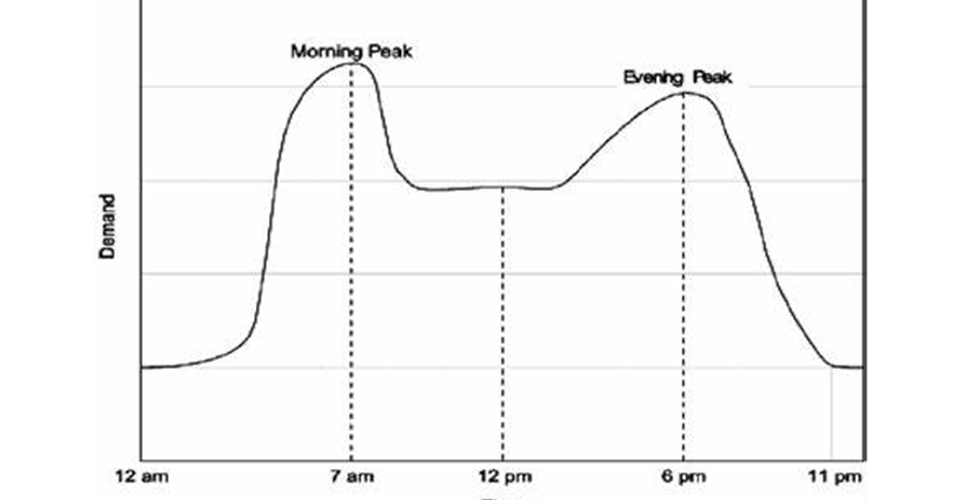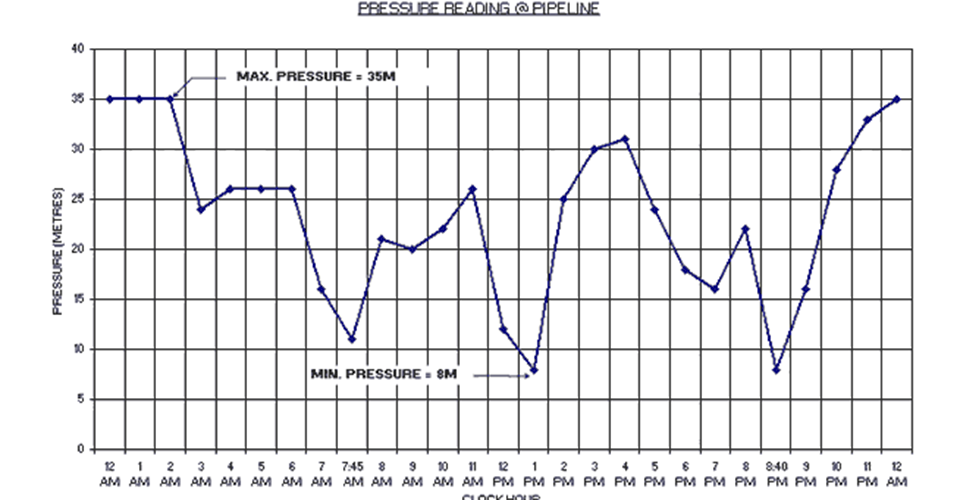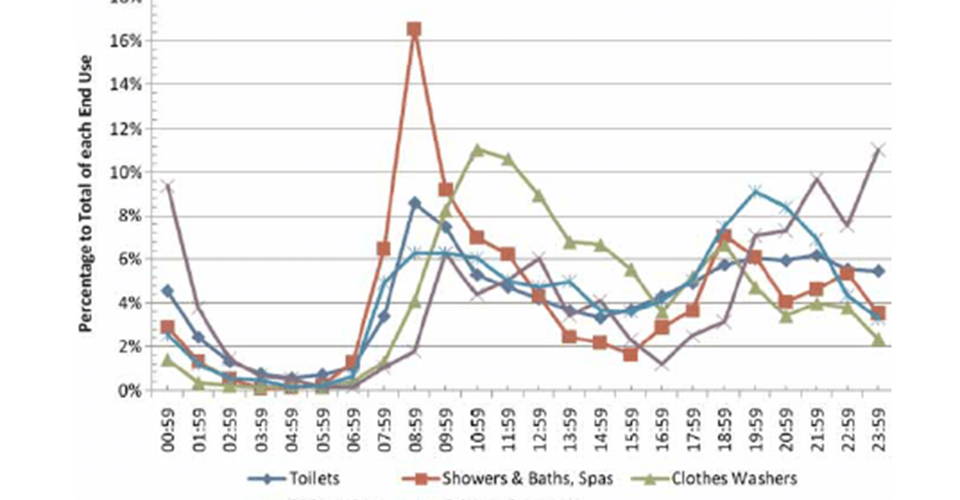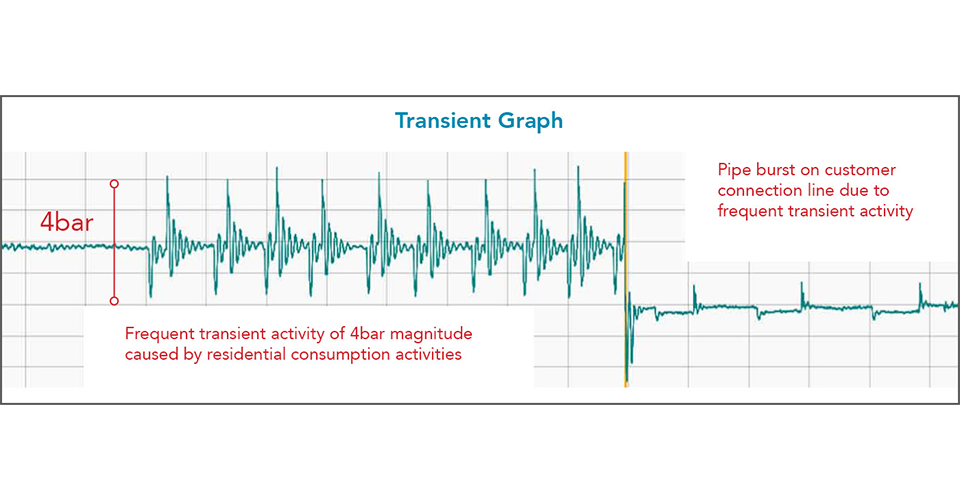This entry in the Iron Strong Blog compares the performance of Ductile iron pipe (DI pipe) to Polyvinyl Chloride (PVC) pipe against cyclic pressure variations in piping systems. Cyclic loading, or more accurately, cyclic surges, is a phenomenon where pressures in a pipeline frequently vary due to changes in demand, operating conditions, storage tank levels, treatment plants, and pump starts and shutdowns. Surges can also occur during common field operations such as exercising or flushing fire hydrants or valves within the system, which can drastically change flow parameters, causing surges or water hammers.
Business and industry contribute to cyclic surges through their varying activities. The frequency and intensity of these cyclic surges can increase over time given growths in the number of households being served, increases in business and industry operational volumes, and unpredictable changes.
Who possibly has such a crystal ball that can accurately foresee such growth and the changes in usage that may or may not follow linearly?
Surge Pressure - The Rule of Thumb
We typically consider transients in pipelines to be more isolated or infrequent events of considerable magnitude. Depending upon the innate flexibility of the pipe material you select, values of 17-psi to 50-psi for each 1-fps increase in velocity have been used as a general design consideration.
The most well-known creator of considerable surges within a pipeline comes from fire flows, where a small diameter pipeline typically operating at or around 300-gpm (3-fps velocity) suddenly needs to deliver 1,800 gpm (18-fps velocity) in a quick demand fire flow scenario. Such an increase in flow rate, inducing a 15-fps velocity change, can cause an instantaneous pressure surge of 250 to 750 additional psi within the pipeline, depending upon the pipe material.
The most important consideration in these scenarios is to ensure the selected pipeline material can contain such elevated pressures. It is comforting to know that even the thinnest wall DI pipe can easily handle more than 1,000 psi.
The subject of typical transients is often covered and routinely shown that DI pipe is vastly superior to any other material in its ability to withstand pressure surges. The discussion of cyclic surges, however, is often missed. On the other hand, cyclic surges are generally of lesser magnitude but more frequent, often many times per day.
Figure 1 below shows what most would expect a typical daily water flow/demand/usage/pressure chart to look like, whereas Figure 2 shows actual flow/demand/usage/pressure fluctuations more accurately. Why and how this happens is relatively easy to understand and comprehend via Figure 3.
These three graphs clearly show what experienced water and wastewater system operators, designers, and managers know: Flows are not consistent and linear, and "typical" only exists in theory.
Cyclic Pressure Effect on My System
How does this affect my system or pipeline, and why is it essential in pipe selection? If you are using DI pipe, it is not important. It does not affect pipe selection, as DI pipe and fittings are not adversely affected over time by cyclic loading, surface scratches, or operational temperature changes.
Unlike plastics such as PVC, DI pipe is not made from a material that has a time-dependent limiting design to failure. DI pipe is not designed using a strength regression curve that is predicated on failure after so many hours at static pressure.
The problem with this philosophy is that given the reality of pipeline operations, as shown in Figures 1-3, we know stable static pressures do not exist in the real world of pipelines, especially water distribution pipelines and wastewater force mains.
A Johns-Manville engineer recognized this conflict between actual reality and plastic pipe design as stated in an article published in the AWWA Journal "PVC pipe has two "funds," one labeled "static pressure life," and the other "cyclic pressure life." The pipe appears to draw on these funds independently. However, if either fund is depleted, the pipe fails. Further, when discussing a cyclic test, Hucks states, "It failed after 223,700 cycles, a value typical of pipe performance."
From the prior charts, we can see cycles exceeding 20 to 50 or more per day to be realistic expectations resulting in a life expectancy of roughly only 30 years. That is only if installed in lab conditions. If the pipe is at all scratched, its life expectancy is dramatically reduced further: "A sample with a 0.005-inch scratch tested to the same cycle pressures failed after 29,000 cycles. A sample with 0.010-inch scratch failed after only 9,600 cycles." Twenty-nine thousand cycles represent just under four years and 9,600 cycles, only 16 months! Hucks concludes with:
"Any method of design* upon which an engineer can make his PVC pipe material selection must include (1) the effect of static conditions; (2) the effect of field damage (scratches); and (3) the effect of dynamic properties. It is recommended that 1. A cyclic hydrostatic design basis (CDB) should be established by testing PVC pipe samples. CDB should define the extrapolated hoop stress to which the pipe can be cycled an infinite number of times. Tests show that for PVC 1120, this value is 1,500 psi. 2. A cyclic hydrostatic design stress (CDS) should be calculated by multiplying the CDB test values by a service factor.”
The video below was produced by the Ductile Iron Pipe Research Association.
A True Case in Point
Erie County, Ohio is just one well-documented case where premature PVC pipe failures could be connected to damage from inappropriate backfill, among other issues. There is no doubt that surges and cyclic pressure variations were also contributing factors. Figure 4 shows a transient graph that depicts how repeated cyclic pressure surges of less than 60 psi can have catastrophic effects on pipe performance. None of the material vs. backfill issues experienced in the Erie County OH case would have affected DI pipe in any way.
If we follow Hucks’ recommendations for PVC pipe design and use a cyclic design basis for distribution system piping according to those recommendations we would have the following results for 8-inch DR 18 using the standard thickness design formula for pressure pipes:
t = P D
2S
Where
t = pipe wall thickness
P = Design Pressure (235 rating with a 2:1 SF)
D = Pipe OD
S = Cyclic Design Basis proposed by Hucks of 1500
t = 470 x 9.05
1500 x 2
t = 4253.5
3000
t = 1.4178 inches
to which a tolerance allowance of 0.06 inches is added.
Pipe wall required thickness = 1.4778 inches rounded to 1.48 inches.
This wall thickness would result in an 8-inch PVC pipe with a 6.09 inch inside diameter, which is slightly smaller than a 6-inch diameter PC 350 DI pipe with a 6.38 inch inside diameter, single cement lining included.
Instead of following Hucks' design recommendations and having a pipe wall thick enough to resist these forces like DI pipe does, PVC pipe attempts to address the issue by requiring the designer/engineer to recalculate the working pressure, design life, and pressure rating of the pipe to fit.
The example in Appendix B of AWWA C-900 assumes a design life of only 50 years and cyclic surge pressure variations of only 30 psi to justify the usage of a DR18 PVC pipe with a wall thickness of about one third as required by Hucks' approach. As we saw in Figures 1-4, cyclic pressure variations often have greater magnitude and frequency than can be reasonably determined before the system being placed into service.
Feel free to have some fun using the Internal Pressure & Materials Comparison Calculator in the McWane Pocket Engineer to see the computed limits of various pipeline materials commonly used in the utility marketplace.
Under Pressure – Ductile Does the Job
So how does Ductile iron pipe resist cyclic pressure surges? Because it is not a thermoplastic, its strength is not affected by time or the repetition of stresses of either large or small magnitude. This requires no more additional design computations, guesstimates, or assumptions of unknown parameters.
AWWA standards for manufacturing DI pipe mandate physical tests at ambient room temperature and -40°F. Everything about PVC and HDPE is based on the temperature always being 73.4°F, which we all know is rarely the actual case. Additionally, every single piece of DI pipe is individually tested hydrostatically to a minimum of 500-psi.
The end-user bears the risks of making so many assumptions with PVC, and as the case in Erie County, Ohio, becomes extremely burdensome on ratepayers if the guesses are wrong. McWane Ductile can help you avoid those problems and construct your pipelines to serve for generations. For more detail on how these factors affect your pipeline design and considerations, contact your local McWane Ductile's Representative.
Let’s conclude with this often-overlooked thought: Cyclic surges from internal pressure are documented and accepted as "wearing" on certain pipeline materials, weakening them over time, even to the point of failure. So much so that it is a real design consideration for those materials. But why is the same "flexing" effect not counted as a cycle every time a truck on a highway rolls over a buried pipeline? How does the material know what is "bending" it? The load is a load, is a load, correct? Not a problem for Ductile but surely a thought to ponder for other materials.
Need Assistance with Your Waterworks Project?
If you have any questions regarding cyclic pressures or pipeline material selection, please contact your local McWane Ductile Representative. We also have team members who have managed small and large water utility systems, served in engineering consulting firms, and bring decades of experience in solving field issues involving pipeline construction and operation. From design to submittal, to installation, we strive to provide education and assistance to water professionals throughout the water and wastewater industry.
Check Out All Our Digital Offerings
References:
https://sanduskyregister.com/news/57885/erie-county-pipe-problems-exposed/
Pipelines 2014: From Underground to the Forefront of Innovation and Sustainability© ASCE 2014,Roy W. Mundy II, P.E., M.ASCE
“Sustainability of Lower Energy Costs by Utilization of Proper Pipeline Materials”, Roy W. Mundy II, P.E., M.ASCE
https://www.epa.gov/sites/production/files/2015-07/documents/preliminary-engineering-report-508.pdf
https://www.epa.gov/tribal/infrastructure-task-force-preliminary-engineering-report
Wesler Engineering, https://info.wesslerengineering.com/blog/developing-a-preliminary-engineering-report-per
Ductile Iron Pipe Research Association - https://www.dipra.org/ductile-iron-pipe-resources/technical-publications/
American Water Works Association (AWWA) (2015). “Buried No Longer: Confronting America’s Water Infrastructure Challenge.”
Design of Water Supply Pipe Networks, Swamee and Sharma
A Framework to Evaluate the Life Cycle Costs and Environmental Impacts of Water Pipelines, Thomas, Mantha, and Carol C. Menassa, University of Michigan
City of Crescent City Water Improvement Project PRELIMINARY ENGINEERING REPORT, Coleman Engineering, http://crescentcity.org/docs/pw/PER/PER%20-%20Crescent%20City%20Water%20Project%207-8-17%20Final.pdf
PRELIMINARY ENGINEERING REPORT Wastewater Treatment Plant Evaluation TOWN OF WAYNESVILLE HAYWOOD COUNTY, NORTH CAROLINA, http://www.waynesvillenc.gov/Data/Sites/1/media/18-sept-11-item-4b-mcgill-and-associates-wwtp-report-full.pdf
Regional District of the Central Okanagan Killiney Beach Water System Preliminary Design – FINAL, AECOM, https://www.regionaldistrict.com/media/204722/KillineyBeach_Pre_Design_Treatment_Options_2015.pdf
WML Consulting Engineers (Pty) Ltd, Square Foot Developments, PRELIMINARY DESIGN REPORT FOR THE ZIVELI BULK WATER SUPPLY PROJECT
Designing PVC Pipe for Water-Distribution Systems, AWWA Journal, July 1972, Robert T. Hucks Jr

